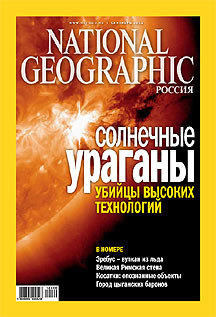National Geographic Russia in September

Solar storms are the main story in the September issue of National Geographic Russia. Forecasts indicate that solar activity will peak in 2013. Solar flares are capable of disrupting electrical systems spanning an entire continent, potentially throwing millions of people into the pre-electrical age for weeks and even months. Are we ready for this?
Also in this issue:
Prickly courtship dance. The male hedgehog can walk on his short legs up to five miles a day in search of a mate. But if the female hedgehog does not like her diligent suitor, she will release her needles.
City of gypsy barons. Tiny Buzescu is unique among remote Romanian provinces: Its luxurious town houses were built by gypsy barons. However, the best rooms in the marble homes go empty for most of the year.
Crazy weather. Unprecedented heat, floods reminiscent of the great deluge and hurricanes that sweep away everything in their path. Such anomalies are increasing. What’s going on with the weather?
Find 10 differences. The painstaking and serious work of scientists resembles children’s play. The photo identification of killer whales helps researchers estimate the size of their population, identify their habitats and determine their species and migration routes.
Borders of an empire. Why did the ancient Romans build impregnable walls and watchtowers if, as historians have found, there is no evidence of raids and military clashes?
Ice and fire. The slopes of the southernmost of the world’s active volcanoes — Erebus — are covered with snow and ice, but a lava lake is constantly bubbling in its depths.
All this and more can be found in the new issue of National Geographic Russia magazine — on sale starting Aug. 30.


